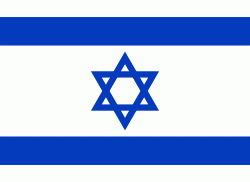Hod HaSharon (Hod HaSharon)
Hod HaSharon (הוֹד הַשָּׁרוֹן, lit. "Splendor of the Sharon plain") is a city in the Central District of Israel. The city is located approximately 10 km east of the Mediterranean coastline, south of Kfar Saba, southeast of Raanana, and northeast of Ramat HaSharon.
Hod HaSharon was officially formed and made a local council in 1964 by the merging of four moshavot: Magdiel, Ramatayim, Hadar, and Ramat Hadar. The land area of Hod HaSharon is 19.2 km2, and according to the Israel Central Bureau of Statistics (CBS), in the city had a total population of.
Before the 20th century, the area of Hod HaSharon formed part of the Forest of Sharon, a hallmark of the region’s historical landscape. It was an open woodland dominated by Mount Tabor Oak (Quercus ithaburensis), which extended from Kfar Yona in the north to Ra’ananna in the south. The local Arab inhabitants traditionally used the area for pasture, firewood and intermittent cultivation. The intensification of settlement and agriculture in the coastal plain during the 19th century led to deforestation and subsequent environmental degradation known from Hebrew sources.
Hod HaSharon was created in 1964 through a merger of Magdiel with Hadar Ramatayim, an administrative body which encompassed the former moshavot of Ramatayim, Hadar and Ramat Hadar. Hod Hasharon was governed by a local council until it was declared a city in April 1990.
A 1,300 year old olive oil factory of mason-worked blocks was unearthed in Hod Hasharon. The leader of the excavation team Durar Masarwa stated, "We discovered the surface on which olive oil was extracted as well as a network of pipes, canals and holes that drained the liquid oil."
Hod HaSharon was officially formed and made a local council in 1964 by the merging of four moshavot: Magdiel, Ramatayim, Hadar, and Ramat Hadar. The land area of Hod HaSharon is 19.2 km2, and according to the Israel Central Bureau of Statistics (CBS), in the city had a total population of.
Before the 20th century, the area of Hod HaSharon formed part of the Forest of Sharon, a hallmark of the region’s historical landscape. It was an open woodland dominated by Mount Tabor Oak (Quercus ithaburensis), which extended from Kfar Yona in the north to Ra’ananna in the south. The local Arab inhabitants traditionally used the area for pasture, firewood and intermittent cultivation. The intensification of settlement and agriculture in the coastal plain during the 19th century led to deforestation and subsequent environmental degradation known from Hebrew sources.
Hod HaSharon was created in 1964 through a merger of Magdiel with Hadar Ramatayim, an administrative body which encompassed the former moshavot of Ramatayim, Hadar and Ramat Hadar. Hod Hasharon was governed by a local council until it was declared a city in April 1990.
A 1,300 year old olive oil factory of mason-worked blocks was unearthed in Hod Hasharon. The leader of the excavation team Durar Masarwa stated, "We discovered the surface on which olive oil was extracted as well as a network of pipes, canals and holes that drained the liquid oil."
Map - Hod HaSharon (Hod HaSharon)
Map
Country - Israel
 |
 |
| Flag of Israel | |
The Southern Levant, of which modern Israel forms a part, is on the land corridor used by hominins to emerge from Africa and has some of the first signs of human habitation. In ancient history, it was where Canaanite and later Israelite civilizations developed, and where the kingdoms of Israel and Judah emerged, before falling, respectively, to the Neo-Assyrian Empire and Neo-Babylonian Empire. During the classical era, the region was ruled by the Achaemenid, Macedonian, Ptolemaic and Seleucid empires. The Maccabean Revolt gave rise to the Hasmonean kingdom, before the Roman Republic took control a century later. The subsequent Jewish–Roman wars resulted in widespread destruction and displacement across Judea. Under Byzantine rule, Christians replaced Jews as the majority. From the 7th century, Muslim rule was established under the Rashidun, Umayyad, Abbasid and Fatimid caliphates. In the 11th century, the First Crusade asserted European Christian rule under the Crusader states. For the next two centuries, the region saw continuous wars between the Crusaders and the Ayyubids, ending when the Crusaders lost their last territorial possessions to the Mamluk Sultanate, which ceded the territory to the Ottoman Empire at the onset of the 16th century.
Currency / Language
| ISO | Currency | Symbol | Significant figures |
|---|---|---|---|
| ILS | Israeli new shekel | ₪ | 2 |
| ISO | Language |
|---|---|
| AR | Arabic language |
| EN | English language |
| HE | Hebrew language |















